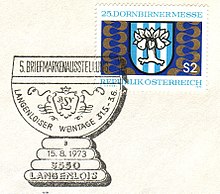Romans (glass)
A Roman is a traditional drinking vessel for wine developed in the 16th century from the forest glass and widespread in Central Europe . The glass today usually has a volume of 0.2 or 0.25 liters.
Word origin
The word is probably derived from vitrum Romarium "Roman glass". This used to describe the material from which these glasses were made, namely fragments of ancient Roman glass, as they were used in Germany for melting. The sometimes contemplated origin of Dutch roemen “boast” is unlikely, especially since Dutch oe is pronounced as / u / and not as / ö /.
history
The term appears for the first time in 1501 in Neuss . The forerunner of the Roman was the so-called Berkemeyer beaker of the 16th century, a green forest glass with a thick base studded with nubs on which the wall rises in a conical shape. A shaft cannot be made out here or is visible as an elongated foot.

In the 17th century is out of this rather crude form of glass classical Romans with ribbed Fußreif, hollow, studded with prunts shaft and cuppa , the bowl-shaped, apple-could be egg-shaped or bulbous. These glasses were widespread throughout Germany and also in the Netherlands. Since Waldglashütten do not sign, the provenance is seldom clearly traceable.
With the Romans in the 18th century, the cup shape of the cup, which is common today, established itself as the standard shape. There are more variations in the other parts of the glass: the base can be smooth instead of ribbed, there are shafts without knobs, and other colors (olive, cobalt blue, brown) appear alongside the natural green of the forest glass.
The Romans of the 19th century developed a great variety of shapes. Nuppies are no longer constitutive in him, and often have completely disappeared; Occasionally, however, they also appear on the kuppa, which was never the case with the baroque Roman. The cup is available in the typical forest glass green, which is now produced artificially, but also in all other colors, but often also colorless. Enamel painting and glass cutting in a wide variety of decors (coat of arms, vine leaves, flowers, geometric ornament) can refine the cup. The shaft can be ribbed like the foot; The shaft and foot often grow together to form a unit. Also balusters shanks are possible. The base and the edges of the lips can be gold-plated.
All in all, this epoch of historicism in glass art is shaped by the endeavor to revitalize the quintessence of the "old German" par excellence: the most diverse stylistic elements of bygone eras come together in a compressed form on the Roman of the 19th century, the decors of rural German tankard painting, the glass cut of the refined Bohemian-Silesian baroque glass, the simple shapes of the forest glass, the balusters in the Venetian style imported to Central Europe . Together they result in hock glasses that revive the Baroque style, which in reality never existed in the 17th century.
Important production facilities for the Romans in the 19th and 20th centuries were the Theresienthal , Wadgassen ( Villeroy & Boch ), Cologne-Ehrenfeld and Rheinbach glassworks .
The Roman today
Numerous replicas of the historicist Roman were commercially available as glass for use in the 20th century. Thick-walled cups made of crystal glass are also known as Romans. The provenance from the forest glass can no longer be recognized here. Due to the dilution in the design language, the term is now often used unspecifically for many types of the classic wine glass with a typical spherical cup and colored, ribbed foot and / or shaft, as the illustration shows.
distribution
Baroque and historic Romans can be found in numerous glass and arts and crafts museums, for example in:
In the antique trade and at glass auctions, both the baroque Romans, which still belong to the forest glass, and the historicist variants are still available in large numbers.
See also
literature
- Sabine Baumgärtner : Glass art from the Middle Ages to Classicism. Bremer Landesmuseum, Focke-Museum, inventory catalog 1987 . Bremen State Museum, Focke Museum, 1987.
- Sabine Baumgärtner: Glass art from Empire to historicism. Bremen 1988.
Web links
Individual evidence
- ↑ Romans. In: Jacob Grimm , Wilhelm Grimm (Hrsg.): German dictionary . tape 14 : R - skewness - (VIII). S. Hirzel, Leipzig 1893, Sp. 1158 ( woerterbuchnetz.de ). Kluge: Etymological dictionary of the German language . Edited by Elmar Seebold. 25th, revised and expanded edition. De Gruyter, Berlin / Boston 2011, p. 772.


